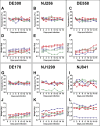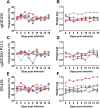Molecular basis of mammalian transmissibility of avian H1N1 influenza viruses and their pandemic potential
- PMID: 28874549
- PMCID: PMC5651783
- DOI: 10.1073/pnas.1713974114
Molecular basis of mammalian transmissibility of avian H1N1 influenza viruses and their pandemic potential
Abstract
North American wild birds are an important reservoir of influenza A viruses, yet the potential of viruses in this reservoir to transmit and cause disease in mammals is not well understood. Our surveillance of avian influenza viruses (AIVs) at Delaware Bay, USA, revealed a group of similar H1N1 AIVs isolated in 2009, some of which were airborne-transmissible in the ferret model without prior adaptation. Comparison of the genomes of these viruses revealed genetic markers of airborne transmissibility in the Polymerase Basic 2 (PB2), PB1, PB1-F2, Polymerase Acidic-X (PA-X), Nonstructural Protein 1 (NS1), and Nuclear Export Protein (NEP) genes. We studied the role of NS1 in airborne transmission and found that NS1 mutants that were not airborne-transmissible caused limited tissue pathology in the upper respiratory tract (URT). Viral maturation was also delayed, evident as strong intranuclear staining and little virus at the mucosa. Our study of this naturally occurring constellation of genetic markers has provided insights into the poorly understood phenomenon of AIV airborne transmissibility by revealing a role for NS1 and characteristics of viral replication in the URT that were associated with airborne transmission. The transmissibility of these viruses further highlights the pandemic potential of AIVs in the wild bird reservoir and the need to maintain surveillance.
Keywords: H1N1; airborne transmission; avian influenza virus; ferret; nonstructural protein 1.
Conflict of interest statement
The authors declare no conflict of interest.
Figures















Comment in
-
NS1 is the fluid for "flu-transmission".Proc Natl Acad Sci U S A. 2017 Oct 17;114(42):11012-11014. doi: 10.1073/pnas.1715239114. Epub 2017 Oct 10. Proc Natl Acad Sci U S A. 2017. PMID: 29073013 Free PMC article. No abstract available.
References
-
- Olsen B, et al. Global patterns of influenza a virus in wild birds. Science. 2006;312:384–388. - PubMed
-
- Scholtissek C, von Hoyningen V, Rott R. Genetic relatedness between the new 1977 epidemic strains (H1N1) of influenza and human influenza strains isolated between 1947 and 1957 (H1N1) Virology. 1978;89:613–617. - PubMed
-
- Smith GJ, et al. Origins and evolutionary genomics of the 2009 swine-origin H1N1 influenza A epidemic. Nature. 2009;459:1122–1125. - PubMed
-
- Taubenberger JK, Reid AH, Krafft AE, Bijwaard KE, Fanning TG. Initial genetic characterization of the 1918 “Spanish” influenza virus. Science. 1997;275:1793–1796. - PubMed
Publication types
MeSH terms
Grants and funding
LinkOut - more resources
Full Text Sources
Other Literature Sources
Research Materials
Miscellaneous

